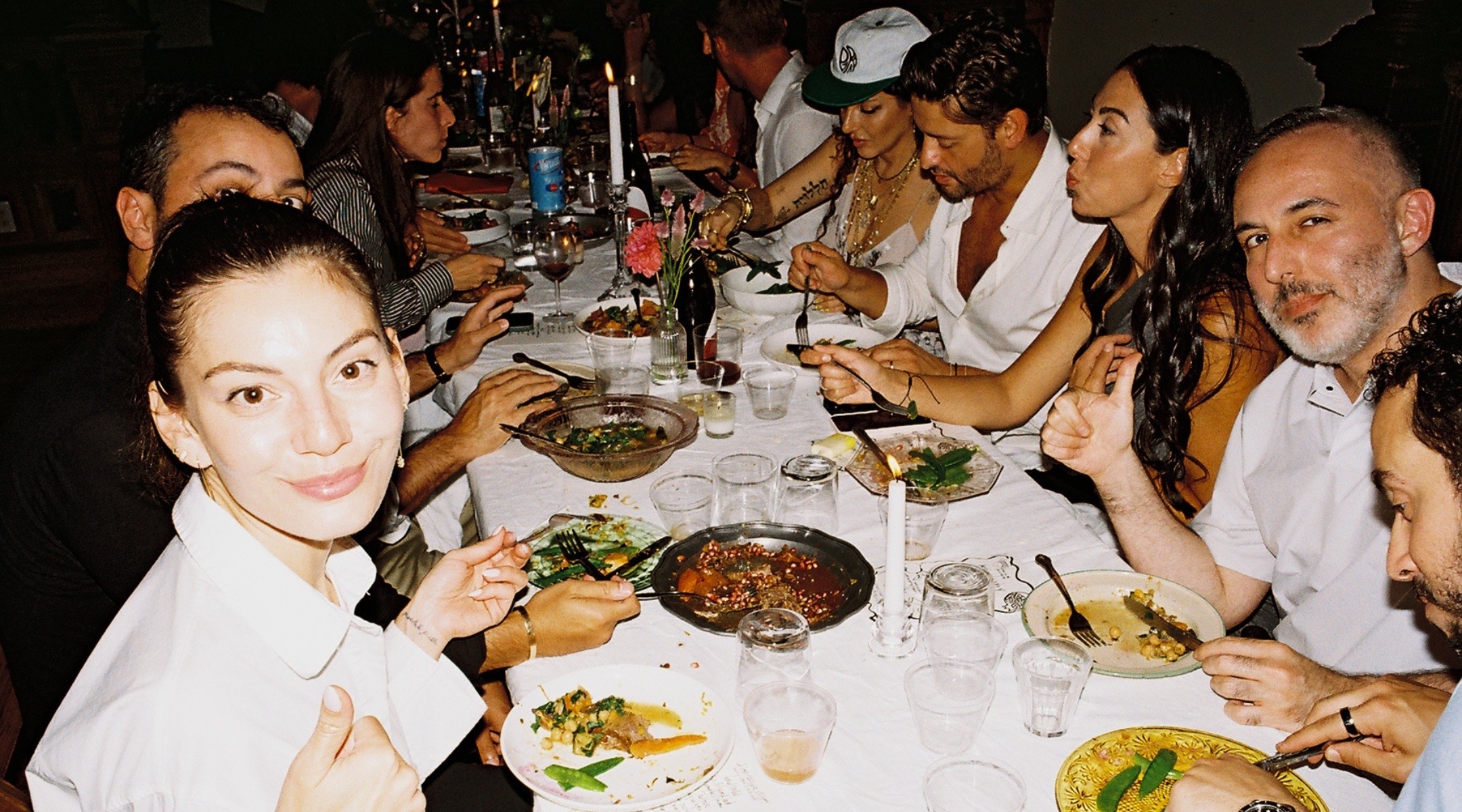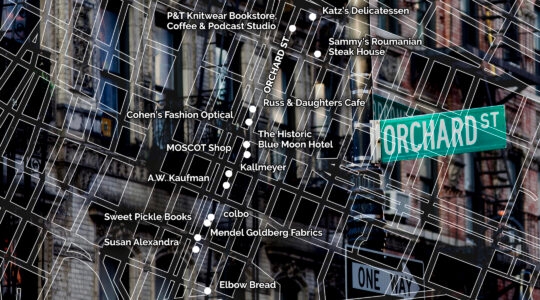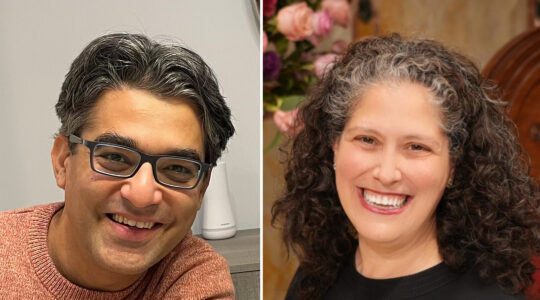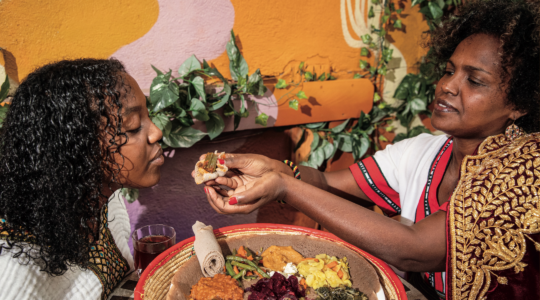At the Council of Fashion Designers of America’s first pre-New York Fashion Week Shabbat dinner on a recent Friday, guests drank New York sours topped off with Manischewitz wine and a challah garnish — though some opted for pickle martinis. Before they sat down to dine, the comedian Modi Rosenfeld, who is also a cantor, led the sleek, chic crowd in a communal kiddush.
In the fall, at a Shtick Shabbat dinner in Chinatown, an elaborate Rosh Hashanah-themed, edible centerpiece allowed diners to swipe challah in honeycomb imported from upstate. Surrounding the centerpiece were moody taper candles and exotic fruits, as well as a fish head on ice — a symbol of the coming Jewish new year. According to Jacqueline Lobel, a producer for food and travel shows who runs the Shtick pop-up series, the dinner aimed to be “a fantastical take on the custom that some of us grew up with.”
And this past summer, dozens of 20- and 30-somethings dressed up in their Shabbat best and went to a Friday night dinner at Moabet, an event space in Williamsburg run by the Israeli restaurant Reunion. The gathering was hosted by Shabbat Club, an independent Shabbat dinner party club run by content creator Morgan Raum. In the brightly lit space, guests enjoyed a cocktail hour, tore into giant challahs, and shared Mediterranean dips, pickles, and salads, all while mingling with strangers and friends — and posting about it on Instagram.
Yes, Shabbat, the traditional Jewish Sabbath, is as old as Judaism itself — the Torah, after all, tells us that God rested on the seventh day of Creation, and thus commanded us to rest. Traditionally, Shabbat is celebrated with a few rituals on Friday night — lighting candles, blessing wine, eating challah — while some people attend synagogue and abstain from working and several practices Jewish tradition associates with it, like spending money or using electricity, for the entire 25 hours that the weekly holiday lasts.
A general decline in synagogue affiliation among non-Orthodox Jews means that many Jews celebrating Shabbat are doing so outside the confines of Jewish institutions. And in New York City, that has brought a new wave of ways to celebrate Shabbat in a more secular — and aggressively stylish — manner, outside traditional Jewish spaces.
The recent CFDA dinner — held at a restaurant at a stylish SoHo hotel — was inspired by a similar one held in Paris during last fall’s Fashion Week there. That Paris soiree was put together by a group formed after Oct. 7 to fight against antisemitism in the fashion and beauty industries.
“Our intent with this dinner was to celebrate not just Jewish culture and customs and the impact the Jewish community has had on American fashion, but to also bring this idea of community… and the joy of a Shabbat dinner to not just designers and friends, but also to people have never been to a Shabbat dinner,” said Marc Karimzadeh, the editorial and communications director at the CFDA, who helped organize the New York event, which drew Jewish designers like Zac Posen and Batsheva Hay.
That was a popup, but other Shabbat events are recurring. In addition to organizations like Shabbat Club and Shtick, which reject a traditional, heimish Shabbat aesthetic in favor of upscale vibes — the Israeli restaurant Mesiba in Williamsburg hosts a lively Friday night Shabbat dinner each week.
Next month, acclaimed Israeli chef Einat Admony will host her first-ever Kabbalat Shabbat service at her Greenwich Village restaurant, Balaboosta, featuring traditional dishes like chraime (a spicy fish stew) and challah as well as a live Moroccan band. There’s also Hot and Holy Shabbat and Hot & Shabbat — two different Friday night events, run by different people, with similar names — that also gather young Jews from around the city, single or paired, for a party with drinks and, occasionally, dinner.
Some of these Shabbat soirées are invite-only, while others welcome the general public. Some are sit-down dinners, while others more resemble the scene at a nightclub. But one thing these Shabbat celebrations all have in common is they seek to highlight the multicultural blend of New York’s Jews, and they also seek to separate these Friday night gatherings from the everyday and lift it into a cohesive, stylish and secular experience.
Some of the growth and interest appears tied to what Jewish Federations of North America recently termed “The Surge” — a wave of Jews who were previously disengaged from organized Jewish life seeking connection and showing up since Hamas’ Oct. 7, 2023, attack on Israel. The group found that nearly 30% of American Jewish adults said they were “only somewhat,” “not very” or “not at all engaged” before Oct. 7 but had begun attending Jewish events since, fueled by a feeling of cultural connection and a desire for safe social spaces.
Morgan Raum held her Shabbat Club’s first-ever dinner on Oct. 6, 2023 — and the tragedy of the Oct. 7 terrorist attacks has since remained in her club’s DNA. (In photos from their events, guests are frequently shown wearing hostage solidarity dog tags, or wearing stickers with the words “F—k Hamas.”) She’s now hosted 16 Shabbat dinners, as well as other Jewish events, and has helped raise money for Asif, the Israeli Food Culture Center, as well as for local restaurants that have been hit with antisemitic vandalism.
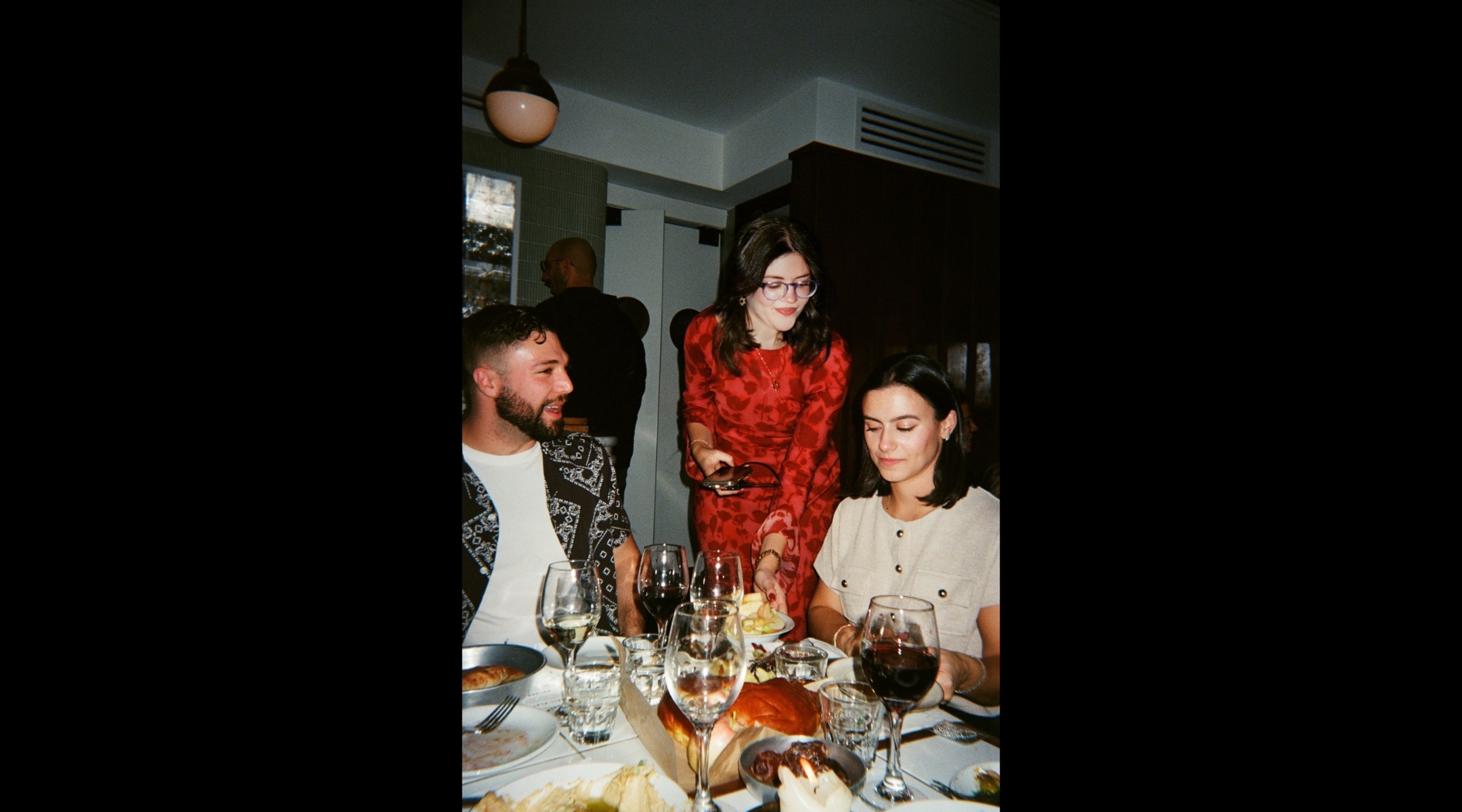
Shabbat Club founder Morgan Raum brings out apples and honeys to guests at a Rosh Hashanah-themed dinner at Israeli restaurant 12 Chairs Café. (Courtesy Morgan Raum)
“I think people immediately just wanted to be with the Jewish community,” Raum, 28, said of Jews’ strong current interest in gathering post-Oct. 7. “People who didn’t know that they wanted to be Jewish, or what Judaism meant to them, suddenly cared and wanted to be involved, but didn’t want to be going to very religious places.”
For Raum, her Shabbat dinners are an occasion to both support Jewish and Israeli restaurants — her dinners have occurred at the likes of Shalom Japan and Sammy’s Roumanian — and also connect with other like-minded young Jewish adults. Shabbat Club attendees tend to be 20- and 30-somethings who “want to still celebrate Judaism and their heritage without turning off their phones or keeping kosher,” she said.
For Meri Goldstein, a 30-year-old based in SoHo, Shabbat Club has become its own Friday night ritual and a place to make new friends. In the two years since her first dinner with Shabbat Club — before it officially launched as Shabbat Club — Goldstein made a new best friend, whom she helped set up with her now-fiancé.
“There’s definitely the aspect of meeting your bashert at Shabbat Club, and I think that happened for quite a few people,” Goldstein said, using the Yiddish word for “soulmate.”
One of the aspects she likes most is “the way they change it up, so it’s never at the same location,” Goldstein said.
Plus, as an interior designer, Goldstein appreciates Raum’s attention to details, such as custom menus, folded napkins and tablescapes. “It’s not just going to Shabbat,” she said. “You feel like you’re going to a nice set dinner that you were formally invited to, and you can dress up for that.”
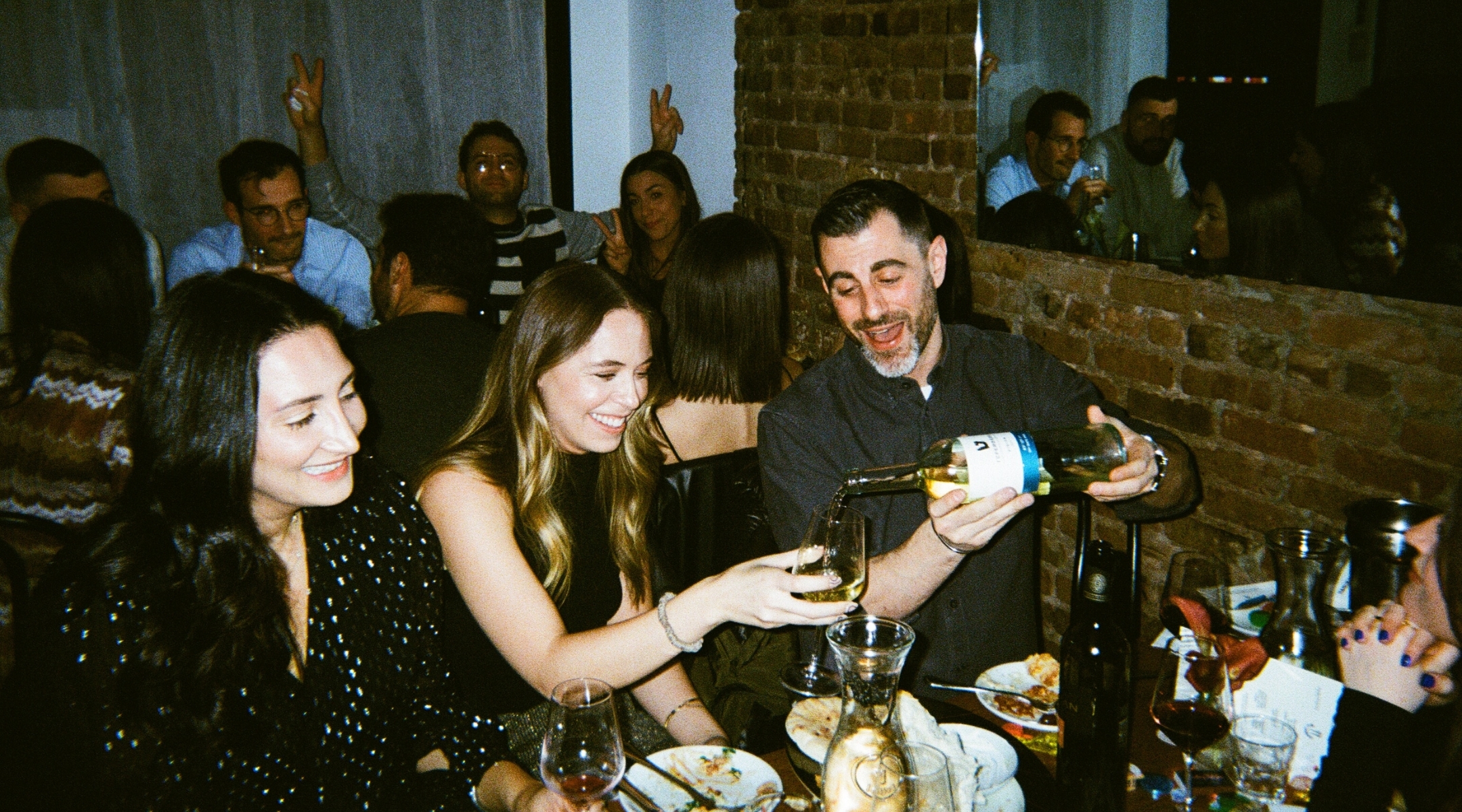
Shabbat Club guests wine and dine the night away. (Courtesy Morgan Raum)
That’s precisely the point, according to Raum. “I want it to be an all-encompassing experience,” she said. “Not just come to dinner, meet a couple people and leave.”
For Lobel, the founder of Shtick, ambience is crucial to creating a good Shabbat dinner experience.
“It just started to bother me a bit that there was nowhere to go in the city for a Jewish hospitality experience outside of, say, deli at Katz’s or Barney Greengrass or Russ and Daughters Appetizing, which, I think we’re very proud as Jews, but we have bagels and lox on lock,” said Lobel, a fourth-generation New Yorker. “There are no candlelit or well-lit [restaurants], or any sort of attention-to-detail type of places where you can go have a drink, have a date, and maybe some brisket.”
Lobel grew up Orthodox in Brooklyn, and while she is no longer religiously observant, her dinners always incorporate some ritual components, like the blessings over the candles, wine and challah. And there’s also deep Jewish inspiration behind everything that goes into a Shtick dinner; the grazing tables that Lobel incorporates in her gatherings, for example, are inspired by an Orthodox Jewish wedding smorg, or cocktail hour, where people mingle around and nosh without sitting.
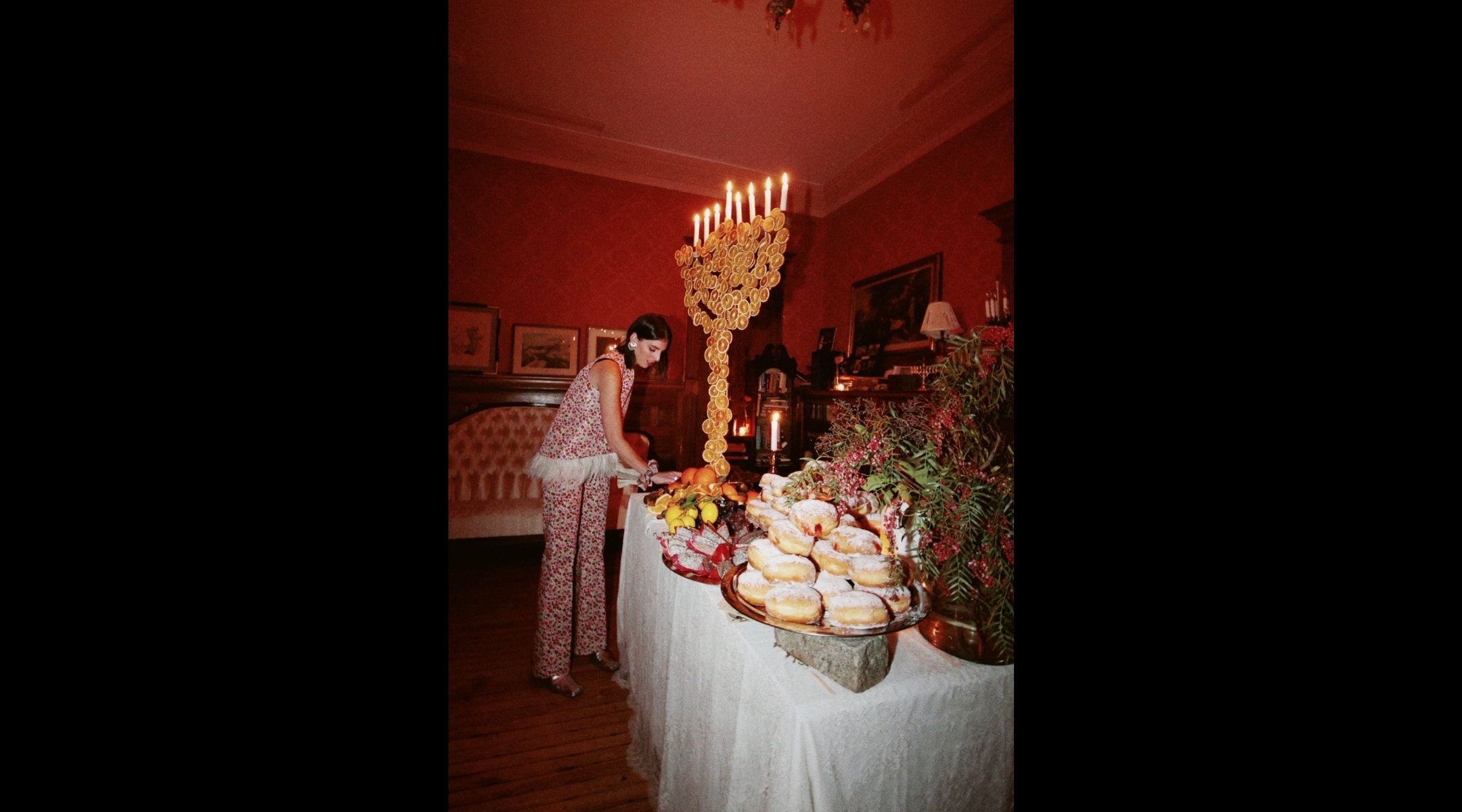
Jacqueline Lobel puts the finishing touches on a Shtick Shabbat dinner table — Hanukkah edition. (Courtesy Jacqueline Lobel)
“I try to look for unique spaces that tell a story, like an old synagogue or a factory or something that looks like we just kind of kicked the door in and, lo and behold, there’s a beautiful candlelit table now,” said Lobel, who once hosted a “secret Soviet seder” last spring inside the Joyva kosher candy factory in Brooklyn.
Vanessa Ochs is a rabbi and professor of religion at the University of Virginia who studies changes in Jewish practices. She said she isn’t worried that the Shabbat social communities are sacrificing anything by skipping religious services in favor of a swanky dinner party.
“I don’t think anything is lost in not going on Friday nights to synagogue,” she said. “For so many years, women never went, and men would go, discharge their obligation, and go home for the big event, which is the meal.”
The meaningful takeaway, she said, is that Jews are finding connection to a core ritual at a time of great need.
“It’s a truly lovely idea that Jews and their friends choose to have some sort of a connection to Sabbath,” Ochs said. “To socialize, to do one of the Sabbath practices, which is to celebrate this moment in time and to do it together, and to connect to some of the very old traditional practices, which probably, for these folks, connect them to their families.”
Another aim of the new-school Shabbat dinners is to embrace the diversity of New York City’s Jewish community — and to welcome non-Jews to the table as well.
At Williamsburg party palace Mesiba, Chef Eli Buliskeria collaborates with a different chef, influencer or Jewish creative to create a unique Shabbat meal and experience each Friday evening.
“The main thing is to create the kehillah, the community,” Elad Zvi, the co-founder of Bar Lab, a hospitality company that operates the restaurant, previously said about Mesiba’s Shabbat dinner series. “We have a lot of diversity between our friends — some of them are Jewish, some of them are not. But the one thing we all have in common: We like to break bread together. We like to eat, we like to drink, we like to party together.”
While Shabbat Club continues to pop around New York’s trendiest Jewish restaurants, Shtick, with its elaborate centerpieces and tablescapes, courtesy of Lobel’s personal stock, is moving to a permanent location on the Lower East Side in the spring, because, according to Lobel, New York needs “more cool Jewish spaces.”
“On a very spiritual level, there seems to be so much darkness in the world, and Shabbat dinners bring a moment of light, which I think we all need at this time,” Karimzadeh said. “And if we can do it in a celebratory, chic way, what’s better than that?”
The New York Jewish Week brings you the stories behind the headlines, keeping you connected to Jewish life in New York. Help sustain the reporting you trust by donating today.
